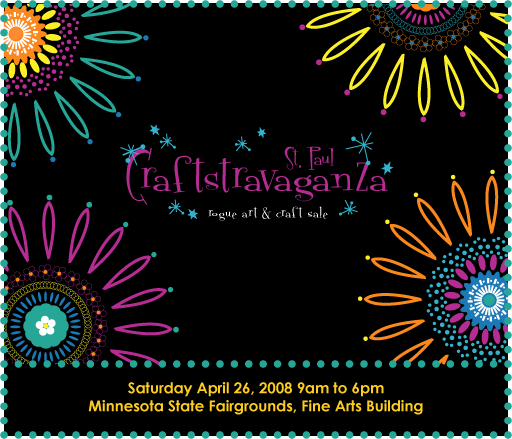Confessions of a Craft Show Organizer
Are you an artisan or craftster ready to dip a toe into the craft show waters? Trish Hoskins, owner of Crafty Planet, answers your burning questions and offers step-by-step advice for making a successful go of selling your work on the craft show scene.








SO, YOU’RE READY TO TURN YOUR CRAFT INTO A BUSINESS by dipping a toe into the craft show waters. There are lots of questions confronting you, right off the bat: What do show organizers look for when selecting their vendors? What should YOU look for in the dozens–if not hundreds–of sales opportunities that present themselves? Once you’ve landed a show, how can you ensure success? Read on, and I’ll walk you through all this and more.
FINDING THE RIGHT SHOW FOR YOU
In case you haven’t noticed, opportunities to buy & sell handmade goods abound for practically every taste–from the traditional country craft fair, to the contemporary fine craft showcase, to the alternative “craftster” show put on by your local indie DIYers. So how do you find them, and which is for you?
To start, check out craft show guides online & in print. I’ve listed a smattering below. Then, check show websites and talk to organizers to get a feel for their aesthetic and audience. Once you make a list of those you find most interesting, sign up for the show mailing list(s) if available. You may want to create a calendar of application deadlines and/or show dates to start planning a tentative schedule. Then finalize your prospects using the following guidelines.
First, understand that there are two basic kinds of shows. One is the juried craft show — all applicants are selected by judges. The other is the non-juried show — an open show — where applicants are accepted purely on a first come, first served basis. Both have their pros and cons, especially for the budding craft artiste.
Open shows can be a low-stress way to test the waters and build your confidence–in your wares and, no less importantly, your salesmanship. Some drawbacks to this kind of show: other vendors may be reselling cheap imports & mass produced goods rather than handmade crafts; product quality may vary wildly; there may be oversaturation in your category; and the show audience may be a poor fit for your business.
Juried shows typically have more applicants than available spots, because it is judged you can’t firm your plans until you’ve gotten the nod. They may also require an application fee which isn’t refunded if you’re rejected. On the plus side, juries typically pay close attention to vendor quality, and shoppers respond well to a high-quality show. In addition, the jury presumably understands the show’s audience and chooses vendors accordingly–so if you do get in, you’re more likely to be successful. Finally, juries also typically restrict the number of spots allotted for each craft category (e.g., jewelry), so you face less danger of over-saturation in your niche.
Later, I’ll give you some tips to help your chances in the jury process, but first let’s run down some other things to consider when evaluating show opportunities.
- How is how the vendor fee structured? Is there a set fee for a certain size spot, or do the organizers take a percentage of sales? If the latter, can you still make a profit with your current pricing?
- What amenities (electricity, wireless/internet) do you need? If available, are they included in the vendor fee, or is that extra?
- Is the show held in conjunction with another event (concert, community festival)? If so, do the audiences of each complement each other?
- If an ongoing show, ask the organizers: Who is the target audience of the show? How many attendees are expected? What is the show’s track record? What types of vendors, products, and price points are most successful? How have past vendors in your price range and/or category done in the past (ask for references)?
- If this is a first-time show, ask the organizers: what is their experience with similar events? What are their plans for marketing and promoting the event?
Once you’ve identified your top show picks, you’re ready to apply. But how can you put your best foot forward in your application?
APPLYING FOR YOUR DREAM SHOW
The pointers below stem from my own experience organizing and jurying craft shows. Remember that my preferences may not be the same as another juror’s, and that shows vary widely in what they’re looking for and expect of their vendors. If in doubt, ask a veteran vendor or a show organizer for suggestions.
- Follow the application instructions carefully. Pay attention to deadlines, and complete all required steps in the application process.
- Submit images in the format and the number requested by the organizers: slides, photos, or digital images. If they ask for three to five photos, they don’t want two—nor do they want ten. Be selective and highlight those pieces you feel showcase your finest work and best tell your story as an artist.
- In taking and choosing your photos, think creatively in order to display your work at its best. Use strong but diffuse lighting to eliminate shadows and make sure details and colors shine through. If appropriate, use live models and props (read the fine print to make sure this is allowed). Consider grouping similar products in a single shot, or submitting a photo of your booth from a previous show (again, if applicable and if it’s allowed in the submission instructions).
- Maintain a consistent aesthetic and focus in the photos you submit. This doesn’t mean limiting yourself to one product; in fact, noting that you can offer a variety of products and price points is usually desirable. Rather, it means that the jurors and the buyer should be able to identify your pieces, on sight, as coming from the same artist. This consistency in “branding” your work communicates what sets your products apart from those of your competition.
- Many applications ask you to describe your goods and/or your artistic vision. Be ready to sum up yourself and your wares in a brief but compelling fashion.
If you aren’t chosen in the first round of picks, and you’re still interested in vending at a given show, ask to be put on the waitlist; but be sure to tell the organizers how much advance notice you will need to attend.
Assuming your dream show has accepted you as a vendor, now comes the fun part—prepping for and selling at the show itself. Through my own experience vending at shows and based on feedback from other vendors, I’ve developed a basic checklist to keep in mind for both stages.
DO YOUR HOMEWORK
- Plan your booth setup and display. Think outside the standard craft fair table! Ask yourself: is a table really the best way to showcase your work? What about gridwall? Do you need a clothing rack? What about a combination of these (vertical displays on a tabletop, e.g.)? If a table is truly best for your showing your wares (or if it’s what you’re stuck with for now) what about getting inventive with the arrangement: you could make an “L”, with one table on the side and another in back to invite shoppers to come in and browse away from the crowding in the aisles; this table arrangement also has the benefit of giving you twice as much display space.
- Take a dry run and set up your booth at least once beforehand. Take pictures and evaluate the set-up objectively on your own or with assistance from a more experienced vendor: Is it eye-catching? Does the display tell your story? Can a passerby easily tell what you make, at a glance (and, what if a crowd were blocking the view)?
- Your “practice run” will also tell you how much time it takes to set your booth up, with or without help.
- Make more product than you think you’ll sell! I advise that you make at least twice as much as you think you’ll need. First, your sales might beat your expectations. Second, latecomers should have a good selection to choose from, too. A full booth looks much more inviting than one that’s been picked-over. How much is enough? You should be able to get some guidance from previous vendors or organizers what to expect, sales-wise.
- On the other hand, if you are still very new to this and the market for your products is still totally untested, you may want to be conservative in building up your inventory of any given product. Here’s where having some variety in products and price points, appealing to different tastes and budgets, can help cut down on your risk. It also can’t hurt to prepare a photo album of your different products, with plenty of order forms, so customers can still place orders if you’re cleaned out.
Now you’re ready for the final step! Your actual craft show debut!
THE BIG DAY
On the day of the show you are, in essence, a small, self-contained retail store. So, think like a store and make sure you have the key elements lined up.
- Employees: You can’t run the booth all by yourself. Line up friends to help throughout the day, so your booth is never unattended.
- Fixtures: Don’t forget your booth displays! A canopy (with weights!) is an essential add-on for outdoor shows.
- Signage: Make sure shoppers can tell who you are, what you do, and how much each item costs. Keep plenty of business cards or flyers on hand, too.
- Inventory: Hopefully you have a place to stash some extra inventory, so you can refresh your stock as it sells and swap out stuff that doesn’t.
- Cash register: Start the day with a “bank” of small bills and change. This could be in a cash box (if someone can keep watch) or in a fanny pack. Determine in advance whether you’ll accept cash only, checks, or credit cards. (These days, I *highly* recommend that you set up a credit card merchant account!)
Of course, a full “how to be successful at craft shows” spiel would take a whole book (and yes, books have actually been written on the subject)—much more space than I have here! Check out the resources below to learn more, or feel free to drop me a line at Crafty Planet. Above all—smile and have fun with it!
___________________________
Related event information:
Field Trip, an annual day-long arts celebration jointly presented by mnartists.org and Silverwood Park, is this Saturday, September 21, 2013 from 11 am to 5 pm at Silverwood Park in St. Anthony, a suburb of the Twin Cities. New to the event this year is an al fresco, Field Trip iteration of the hugely popular winter craft fair, No-Coast Craft-O-Rama. Find out more about the Summer No-Coast Craft O Rama here: http://nocoastcraft.com/nocoast/summer-nocoast/
This article was originally published in March 2008 on mnartists.org.
___________________________
About the author: Patricia Hoskins owns Crafty Planet in Minneapolis and is one of the founders of the hugely successful craft show, No-Coast-Craft-O-Rama.
A SHORT INDEX OF CRAFT RESOURCES
Craft show directories
ACE Guide: Predominantly “traditional” craft fairs; good commentary on the included shows (fees, what price ranges sell best, etc).
FestivalNet: A bit more comprehensive, but full access requires a subscription.
Midwest Art Fairs: Focused exclusively on the Midwest region; quite comprehensive. Full access requires a subscription, but your local library may carry the print version.
Indie Craft Shows: Specifically limited to listings of “indie”/alternative craft fairs.
Sunshine Artist Magazine Directory: In addition to the listings, there’s a nice archive of articles on topics of interest to craft vendors.
Local indie craft shows
These are my favorites, but of course there are lots of other opportunities locally and regionally:
No Coast Craft-o-rama (annually in December and, as of 2013, in September)
Craftstravaganza in April, in St. Paul and Craft’za, in Minneapolis in November)
Craft business information & networking
The Switchboards: forum for “creative women” to discuss all kinds of business and creative topics.
American Crafts Council: An association promoting fine and contemporary craft.
Crafts Report: a trade journal targeted to the fine craft artisan, but chockfull of business tips and information
Recommended Reading
Ilasco, Meg Mateo. Craft, Inc.: Turn Your Creative Hobby into a Business. Chronicle Books, 2007.
Brabec, Barbara. The Crafts Business Answer Book: Starting, Marketing, and Managing a Home-based Art, Crafts, or Design Business. M. Evans, 2006.
Kadubec, Phil. Crafts and Craft Shows: How to Make Money. Allworth Press, 2000.